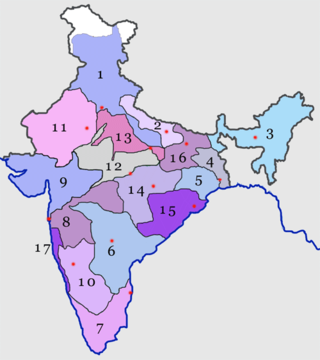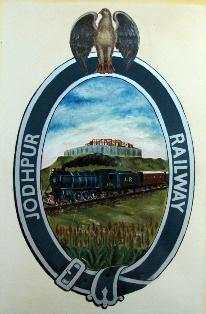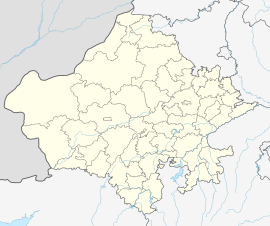
The North Western Railway is one of 19 railway zones in India. It is headquartered at Jaipur, Rajasthan and has 59,075+ employees, 658+ stations and a route length of more than 5,761 kilometres (3,580 mi) across the states of Rajasthan, Gujarat, Punjab and Haryana. NWR operates international rail service Thar Express from Jodhpur to Karachi. This zone is the key enabler of the Delhi–Mumbai Industrial Corridor Project by virtue of running railways 1,500 km long Western Dedicated Freight Corridor.

The Northern Railway (NR) is one of the 19 Railway zones of India and the northernmost zone of the Indian Railways. It is headquartered at Baroda House in New Delhi.
The Thar Express was an international passenger train that ran between the Bhagat Ki Kothi a suburban area of Jodhpur in the Indian State of Rajasthan and Karachi Cantonment of Karachi in the Pakistani Province of Sindh. The name of the train is derived from the Thar Desert a sub-continental desert, which lies in the north-western part of the Indian subcontinent and ranks 17th in the world covering an area of 200,000 km2 (77,000 sq mi).
Bhagat Ki Kothi railway station is a railway station on the North Western Railways network in the state of Rajasthan. It is located approximately 3 km from Jodhpur Junction.

The Moradabad–Ambala line is a railway line connecting Moradabad in the Indian state of Uttar Pradesh and Ambala Cantonment in Haryana. The line is under the administrative jurisdiction of Northern Railway.

The Ambala–Attari line is a railway line connecting Ambala Cantonment in the Indian state of Haryana and Attari in Punjab. The line is under the administrative jurisdiction of Northern Railway.

The Jalandhar–Jammu line is a railway line connecting Jalandhar Cantonment and Jalandhar City in the Indian state of Punjab with Jammu Tawi in Jammu and Kashmir. The line is under the administrative jurisdiction of Northern Railway. This line was made after Indian Independence in 1947. Normally before partition of India and creation of Pakistan, trains to Jammu Tawi from Delhi used to run via Panipat, Ambala Cantonment, Ludhiana, Jalandhar City, Amritsar, Lahore, Narowal and Sialkot. But after partition and creation of Pakistan in 1947, the Sialkot–Jammu Tawi line was dismantled and closed permanently. Jammu and Kashmir became cut off from rest of India. Hence in 1949, it was decided to extend the line from Jalandhar City to Mukerian till Pathankot and after the Indo-Pakistani War of 1965, this line was extended to Jammu Tawi. This 216 km (134 mi) railway line is an important strategic connectivity for Indian Military and Defence.

The Delhi–Fazilka line is a railway line connecting Delhi and Fazilka the latter in the Indian state of Punjab. There is a link to Firozpur Cantonment. The line is under the administrative jurisdiction of Northern Railway. This line was a part of the historic Delhi–Karachi line.
Munabao railway station is located in Barmer district in the Indian state of Rajasthan. It is a railway transit point on the India–Pakistan border.
The Marwar Junction–Munabao line connects Marwar Junction, on the Jaipur–Ahmedabad line to Munabao, the last station in India, near the India–Pakistan border. Both are in the Indian state of Rajasthan. There is a link to Jodhpur. This line operates under the jurisdiction of North Western Railway zone.

The Jodhpur–Bathinda line connects Jodhpur, in the Indian state of Rajasthan to Bathinda in the Punjab, via Dabwali Railway in Haryana. During the British Raj, Bathinda was on the Delhi–Karachi line and after independence and partition of India in 1947, it is on the Delhi–Fazilka line. This line operates under the jurisdiction of North Western Railway.
Bikaner railway station is located in Bikaner district in the Indian state of Rajasthan. It serves Bikaner. Bikaner is headquarters of Bikaner railway division.
Chittaurgarh Junction railway station is one of the major railway junctions in Southern Rajasthan, India. The railway station of Chittorgarh is located on a broad-gauge line and falls under the administrative control of Western Railway Zone of Indian Railways and consists of seven main railway platforms.

Bikaner railway division is one of the four railway divisions under North Western Railway zone of Indian Railways. This railway division was formed on 5 November 1951 and its headquarter is located at Bikaner in the state of Rajasthan of India.
Hisar Junction railway station is an A-category railway station, under the Bikaner railway division of North Western Railway zone of Indian Railways, located at Hisar city in Hisar district of Haryana state of India. The station consists of 6 platforms, with 6 broad-gauge mostly electrified tracks of Bathinda–Rewari line and Jakhal–Hisar–Sadalpur line, going in 4 directions at an average speed of 120 km/h. Hisar is one of the 400 stations to be redeveloped with international and private partners for modernization on international standards and optimizing the commercial opportunities.

The Jodhpur–Bikaner Railway (JBR) was a 1,000 mm metre gauge railway, jointly owned and operated by the Jodhpur State and Bikaner State until 1924 when the system was split between the newly formed Jodhpur State Railway and Bikaner State Railway.

The Jodhpur State Railway (JSR) was formed in 1924 and took over responsibility for working the Jodhpur section of the Jodhpur–Bikaner Railway, and the British section of the Jodhpur-Hyderabad Railway.

The rail network in the state of Haryana in India, is covered by five rail divisions under three rail zones: North Western Railway zone, Northern Railway zone and North Central Railway zone.
The Merta Road–Rewari line or Merta Road–Phulera–Rewari line is a railway route on the North Western Railway zone of Indian Railways. This route plays an important role in rail transportation of Bikaner division, Ajmer division and Jaipur division of Rajasthan state and Gurugram division of Haryana state.

The Jodhpur–Jaisalmer line or Jaisalmer–Jodhpur line is a railway route on the North Western Railway zone of Indian Railways. This route plays an important role in rail transportation of Bikaner division, Jodhpur division of Rajasthan state.











